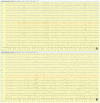X-Linked Epilepsies: A Narrative Review
- PMID: 38612920
- PMCID: PMC11012983
- DOI: 10.3390/ijms25074110
X-Linked Epilepsies: A Narrative Review
Abstract
X-linked epilepsies are a heterogeneous group of epileptic conditions, which often overlap with X-linked intellectual disability. To date, various X-linked genes responsible for epilepsy syndromes and/or developmental and epileptic encephalopathies have been recognized. The electro-clinical phenotype is well described for some genes in which epilepsy represents the core symptom, while less phenotypic details have been reported for other recently identified genes. In this review, we comprehensively describe the main features of both X-linked epileptic syndromes thoroughly characterized to date (PCDH19-related DEE, CDKL5-related DEE, MECP2-related disorders), forms of epilepsy related to X-linked neuronal migration disorders (e.g., ARX, DCX, FLNA) and DEEs associated with recently recognized genes (e.g., SLC9A6, SLC35A2, SYN1, ARHGEF9, ATP6AP2, IQSEC2, NEXMIF, PIGA, ALG13, FGF13, GRIA3, SMC1A). It is often difficult to suspect an X-linked mode of transmission in an epilepsy syndrome. Indeed, different models of X-linked inheritance and modifying factors, including epigenetic regulation and X-chromosome inactivation in females, may further complicate genotype-phenotype correlations. The purpose of this work is to provide an extensive and updated narrative review of X-linked epilepsies. This review could support clinicians in the genetic diagnosis and treatment of patients with epilepsy featuring X-linked inheritance.
Keywords: X-linked; developmental and epileptic encephalopathies (DEEs); epilepsy; genetics.
Conflict of interest statement
None of the authors has conflicts of interest to declare in relation to the present review.
Figures






References
-
- Germain D.P. General aspects of X-linked diseases. In: Mehta A., Beck M., Sunder-Plassmann G., editors. Fabry Disease: Perspectives from 5 Years of FOS. Oxford PharmaGenesis; Oxford, UK: 2006. Chapter 7. - PubMed
Publication types
MeSH terms
Substances
LinkOut - more resources
Full Text Sources
Medical
Miscellaneous

